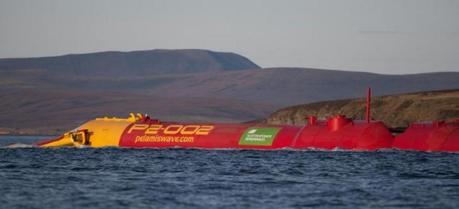 ScottishPower Renewables' Pelamis P2 machine arriving in Orkney, Scotland. (Credit: Pelamis Wave Power)
ScottishPower Renewables' Pelamis P2 machine arriving in Orkney, Scotland. (Credit: Pelamis Wave Power)Tank testing of scale models to develop the next generation of Pelamis Wave Power’s wave energy converter (WEC) machines has now been successfully completed. The tank testing process forms a key part of a £1.4m ($2.25m) project commissioned and funded by the Energy Technologies Institute (ETI) which is looking to boost the cost-effectiveness of large-scale WEC arrays in UK waters.
The Pelamis Wave Energy Converter is a technology that uses the motion of ocean surface waves to create electricity. The machine is made up of connected sections which flex and bend as waves pass; it is this motion which is used to generate electricity. Developed by the Scottish company Pelamis Wave Power (formerly Ocean Power Delivery), the Pelamis became the world’s first offshore wave machine to generate electricity into the grid, when it was first connected to the UK grid in 2004.The two 29th scale Pelamis P2e models featured a number of potential improvements to the current Pelamis P2 machine. The improvements included larger and elliptically shaped tubes, different numbers of joints and tube lengths together with enhanced control systems. The tank testing also allowed for the most extreme storm conditions to be applied over extended periods of time.
The testing was undertaken over a one month period in a specialist wave tank—known in the industry as a ‘wave basin’—at the Ecole Centrale de Nantes (ECN) in France. The models were exposed to the full-scale equivalent of 50 hours of extreme storms, in which the largest waves were up to 23m high. These results drive the engineering design program and provide robust evidence for verification purposes.
Pelamis is actively controlled by sophisticated computerized control systems which can dramatically increase power capture. In the tank tests new control algorithms showed an increase of 100% more power capture in small and medium seas than those previously implemented. This demonstrates huge potential reduction in the cost of energy from Pelamis wave energy converter technology achievable through software upgrades alone. On-going improvements of the machine geometry and controls offers further dramatic gains long into the future.
The ‘P2e’ Pelamis wave energy converter design is larger, more powerful, and developed for volume production and long term reliability. These improvements will satisfy the demand for commercial scale wave farms currently being developed in Scottish waters and beyond. The new P2e Pelamis design, now moving into the detailed design phase, builds on the successful demonstration of two P2 machines in Orkney at the European Marine Energy Centre (EMEC).
Ross Henderson, Technology Director at Pelamis Wave Power, said: “We’ve learned so much from the P2 machines being demonstrated in Orkney. Alongside our intensive R&D programme, this is allowing us to make big advances. The new P2e design must provide a return for the first commercial project investors and this means more power throughout the year but without more cost. We have found that the fundamentals have been proved right with the Pelamis so far, so we’re taking the P2 technology platform and enhancing it into a much more powerful, reliable, and economic machine. Continuing in this way, we will steadily make wave energy cost competitive with other sources in the years to come.”
Earlier we reported that a somewhat similar Aquamarine Power’s Oyster wave energy converter technology has already received full consent from the Scottish Government for a 40MW wave farm off the north-west coast of Lewis, Scotland. Recently Scotland has become a hot place for ocean energy projects. For example, this year Alstom has for the first time successfully generated electrical power using its new 1MW tidal power turbine at a test site located in Orkney, Scotland.
ETI Marine Program Manager, Simon Cheeseman, said: “Seeing such encouraging increases in power capture within these test results is exactly the kind of technology development that we had hoped to see. We are working with Pelamis to accelerate the wave power technology development that the industry requires in order to reach that next step towards commercialization. The project is designed to help improve technology performance and reduce the cost of wave energy.”
These extreme test wave conditions were guided by real wave measurements from a South Shetland site where a wave farm is currently being developed by Aegir Wave Power, a joint venture between Pelamis Wave Power and Vattenfall. The site was also chosen thanks to the energetic wave resource found in South Shetland, meaning that the wave conditions the model P2e machines experienced during tank testing were representative of one of the most energetic wave sites in the UK.

